Viticulture with the Tuscany Expansion Review
There’s something about the Stonemaier gaming experience that just clicks with us. They are beautiful, easy to learn yet full of depth, and we always finish a game feeling like we really went on a journey.
Whether it’s building a new civilization in Tapestry, starting pie fights in My Little Scythe, or learning about birds in Wingspan, Stonemaier has a way of weaving theme beautifully and satisfactorily with mechanics so that players are fully immersed.
One game that we haven’t talked about in depth here yet, but that has been delighting us for years is Viticulture.
This is a go-to date night game for us and we have recently fallen in love with it even more with the addition of the Tuscany expansion.
We always recommend Viticulture to friends and readers looking for a great worker placement game to try. And while the base game is excellent, playing it with the Tuscany expansion is now our preferred way to play and we’d love to share why!
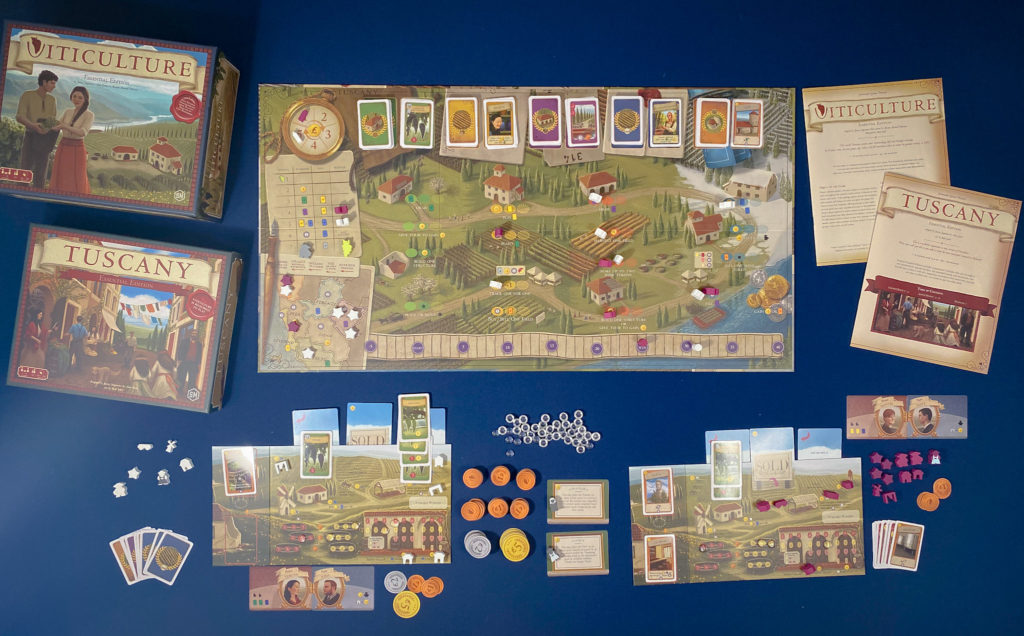
What is Viticulture Essential Edition and Tuscany Essential Edition?
Viticulture Essential Edition (Viticulture) is a game all about making wine on your vineyard as you grow your winery into a successful operation.
Here you’ll use your workers to perform important tasks on the vineyard throughout the year to grow grapes, make wine, expand your vineyard, and fulfill orders.
Tuscany Essential Edition (Tuscany) features three expansions to the Viticulture base game along with a new expanded, double sided board.
For this review, I am going to talk about the base game as played with the expansion. For the sake of brevity, and to save my fingers extra typing, I’ll just be referring to the game as Viticulture.
Quick Gameplay Overview:
Like many Stonemaier Games, when placed out on the table, Viticulture can look overwhelming. Luckily, Viticulture is easy to pick up and get playing in just a matter of minutes.
I want to give you a quick run down of the rules without getting too much into the nitty gritty of it all. But I do want to say, if you have any reservations about learning Viticulture on your own, it has one of the best written rulebooks. It is extremely easy to follow and does a fantastic job of getting you up and running, playing your first game quickly. The Tuscany expansion similarly has a very well laid out rulebook that takes mere minutes to learn after learning the base game.
But to give you a quick idea, here’s a brief rundown of what you’ll do in Viticulture with Tuscany:
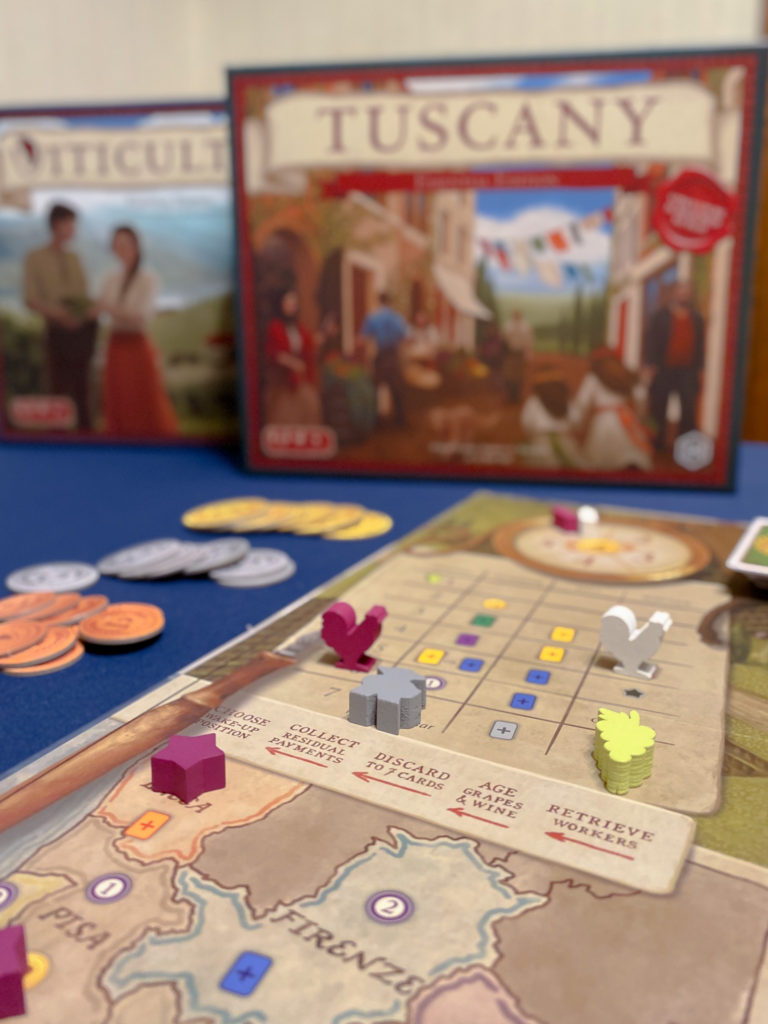
The game is played out on a main central board that is broken up into seasons. Each round is considered one year of time for your vineyard and you’ll play as many rounds as needed until someone earns 25 points to end the game.
Using the wake-up chart, players will select the play order for that year. As you progress through the seasons, you’ll move your marker, gaining any benefit for that season.
The actions available to your workers are determined by which season you are currently in. Spring Actions are taken first, then once you move into Summer you may choose the Summer Actions, then Fall, and finally Winter. To take an action, you place one of your workers on an available action space, gaining any bonus actions if applicable.
If there are no available spaces because other workers are already placed on them, you cannot access those spaces. However, each player has one Grande Worker that allows them to use an action even if it is occupied by opponents.
While the actions are taken on the main board, any benefits received are added to your personal board.
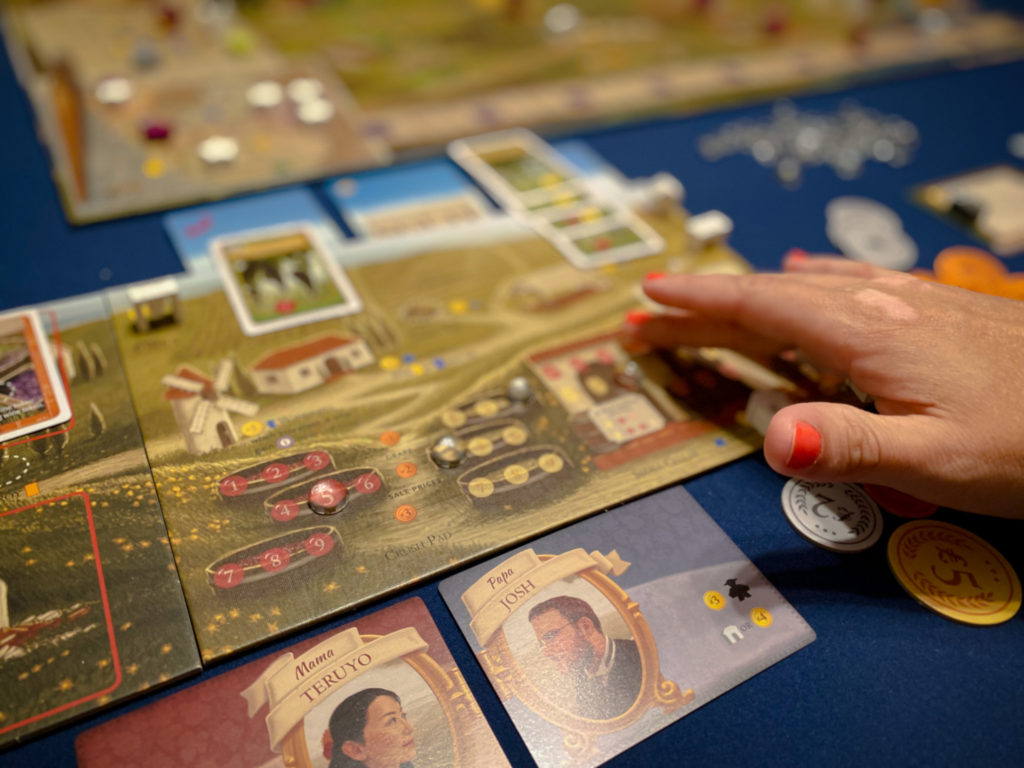
This board represents your vineyard where you have your fields, buildings, crush pads, and cellars to store wine. Here you’ll plant grapes, harvest your crops, and create wines to fill orders.
A year is over once all players have used all their workers.
Players immediately select their player order for the next year as they cross out of the Winter season in the Wake-Up chart. Once all players have done this, the next year begins.
What do we think?
We aren’t typically people who grab expansions right away. In fact, it took us years to get the Tuscany expansion for Viticulture even with us considering it one of our very favorites. Why? Well our typical philosophy on expansions is that if we are happy with the base game, then we’re probably okay without the expansion.
So why do I now recommend Viticulture with the Tuscany Essential Edition expansion?
Because it truly improves the game dramatically in ways I didn’t know I was looking for! And because of that, if you are going to pick up a copy and learn Viticulture, you might as well learn it with the Tuscany expansion from the get go!
You certainly don’t have to, as I said, we’ve been happy with the base game for years. But Tuscany feels different than a typical expansion to me. The best part of playing Viticulture with Tuscany, is that you can choose which of the expansion modules you want to add and which you do not.
The Expanded Board is the Best Board
My biggest love for Tuscany comes from the new, expanded board that has all of the actions broken down into four seasons rather than the original two, (summer and winter) and the new wake-up chart where players will choose their player order.
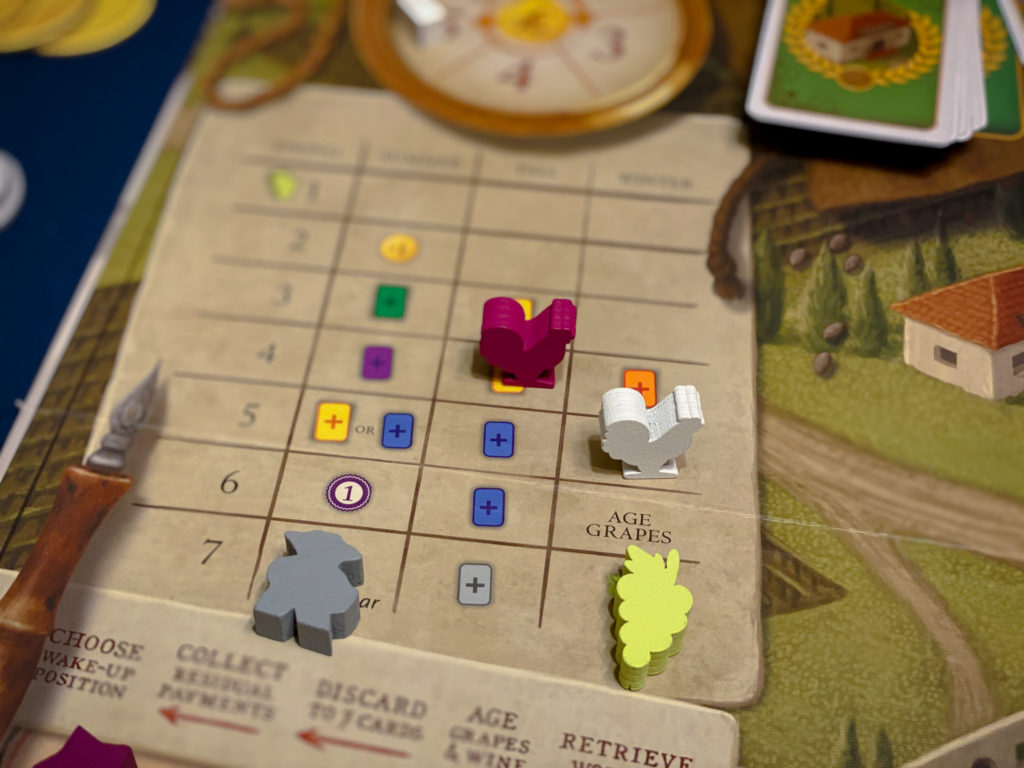
The Wake-Up chart is a game changer for me. The bonuses available here really help players get their plan up and running more quickly. You’re able to get your hands on more cards earlier, (particularly visitor cards which can greatly help in the game) without having to use a worker to draw them, saving your actions for more valuable moves.
For those familiar with the base game of Viticulture, the expanded board also offers a few new action selections, all of them great additions to the game.
First, and perhaps most notably is the Summer Trade action. Here is a great way to trade something you don’t have use for for something you do. Players who are struggling to get enough coin to build buildings, or have cards they don’t need can find help here that may provide the boost they need to make the most of their year.
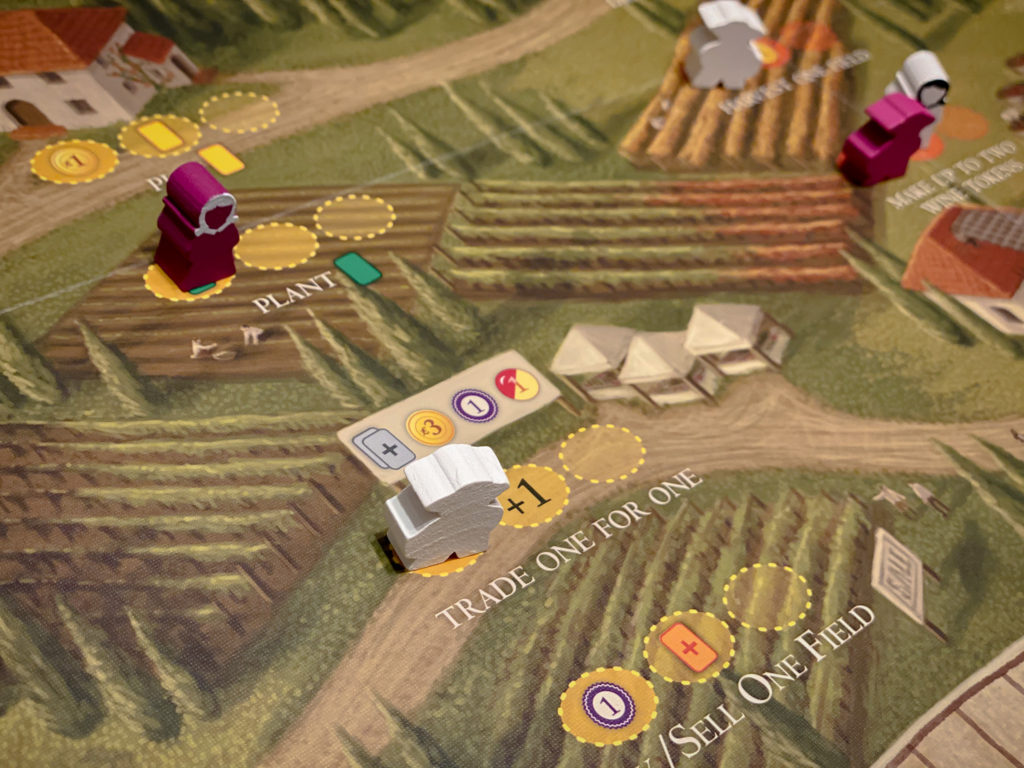
I also love that the fall provides players with a second opportunity to build a structure on their board. Too often that spot got used up in the original game and you’d have to wait an entire year to build something. Opening another slot greatly helps all players, especially in higher count games.
I could definitely see that if you really enjoy the cutthroat nature that can come from worker placements, that the expanded board might open the game up a bit too much for you, creating too many avenues to earn points in different ways. However, I still find the game to play very tight. Going forward, I’m fairly confident that every game of Viticulture I play will be played with this board.
The best news is that even if you just want to play the game without any of the expansion modules, you can still use the expanded board. For me, it just looks so much better. I absolutely love all of the actions being perfectly separated into their seasonal slots. This has made teaching the game to new players a bit easier too because it automatically makes sense visually.
But we don’t just love and recommend playing Viticulture with the Tuscany Expansion for the board. We also love the expansion modules that are available!
Expansion Modules
Each of these modules really added some depth to the game without increasing the difficulty. We have been able to seamlessly teach Viticulture with the expansion modules, to brand new players. And they caught right on loved it!
Each of these modules can be used together or separately in any game that you play. Include, one, two, all three or none. It all works!
Special Workers
I have absolutely loved these special workers! During the game you have the opportunity to train new workers to add to your worker pool. When playing with Special Workers, you can train a worker at slightly more cost that will also be able to perform a special skill. There are two Special Workers per game and each are available to all players, though you may only have one of each.
All of the abilities are very interesting and we have been enjoying finding ways to use them to our advantage each game.
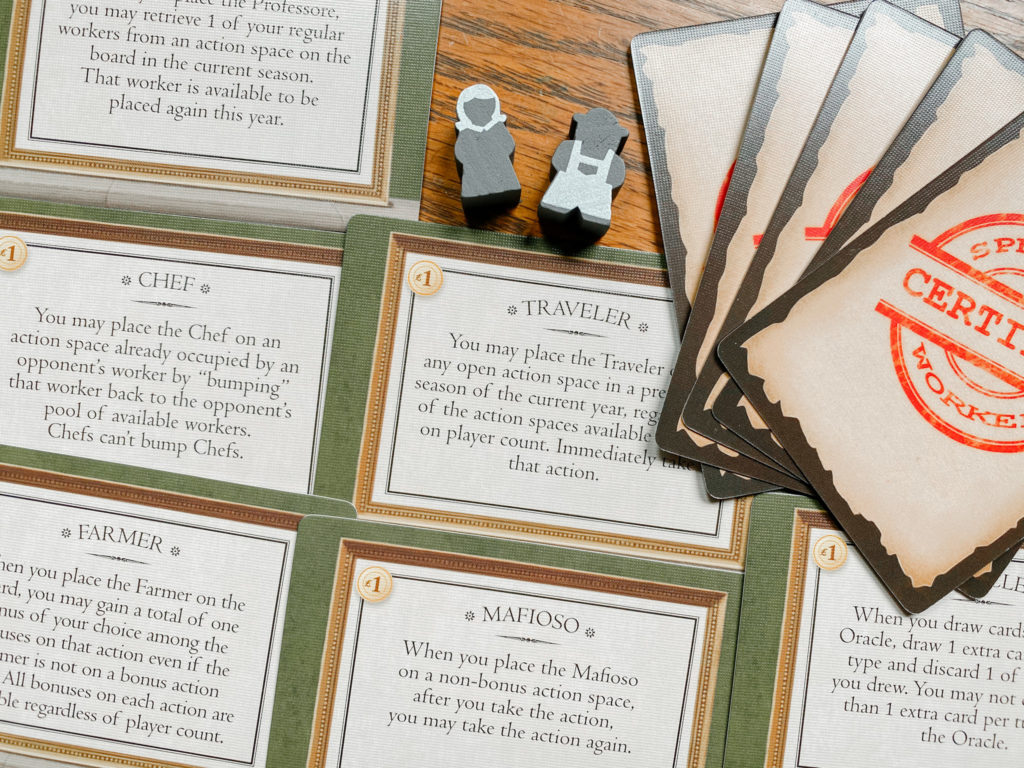
Structure Cards
We greatly enjoyed the structure cards. Both thematically and mechanically! Thematically, it was so fun to be able to build unique structures that set your vineyard apart from everyone else, just like you’d find in real life if you were to go visit different wineries. For instance, in one game, Adam built a statue and a taproom, structures that we could imagine being draws to folks visiting a winery, this helped him with his tour giving strategy. While I built a mixer that allowed me to produce higher quality wines, aiding my wine order strategy. Each were very different, yet both delivered results and the game was neck and neck until the end.
Structure cards are something that you’ll probably want to play with each game because with so many different options available, they really keep Viticulture feeling fresh and provide new avenues for players to earn victory points.
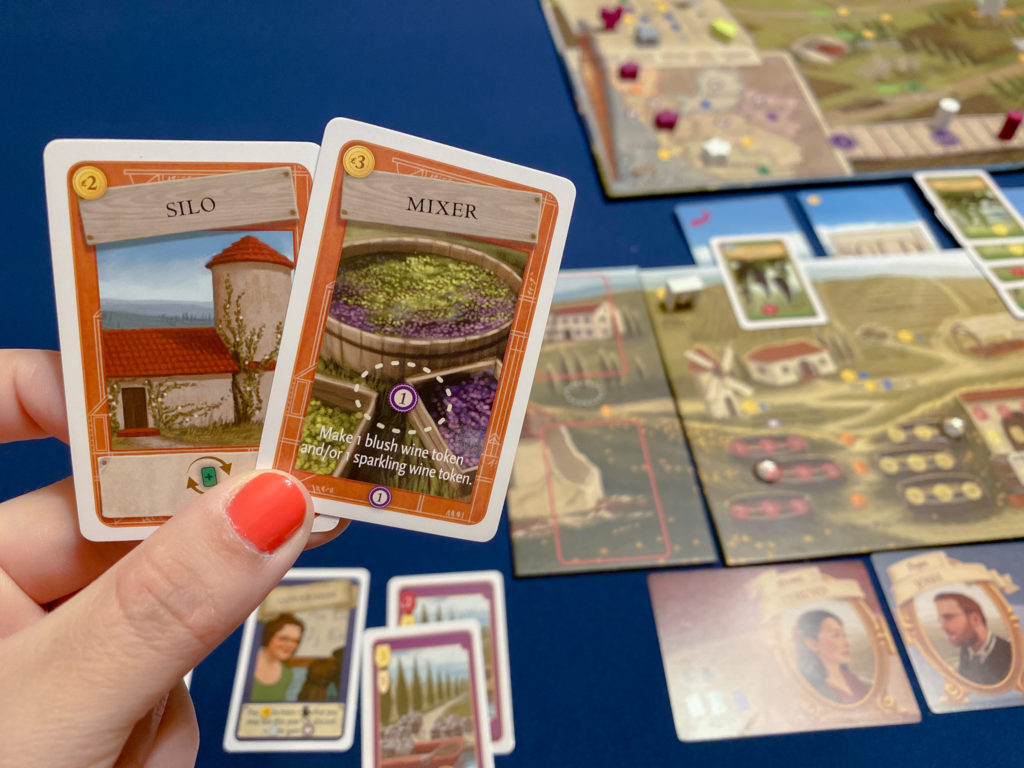
Area Majority – The Game Within the Game
The expanded board features a small map of Tuscany in the lower left. Players are able to take actions that allow them to place or move one of their 6 stars onto the map. When players do this, they earn the bonus from the region that they placed their star. And at the end of the game (when played with 3 or more players) if you happen to have a majority in a region on the map, you’ll be awarded with the victory points for that region to your final score.
Feeling less thematic, this is a take it or leave it element of the game for me. It’s nice to have the map so that you can draw different cards that you may otherwise be unable to draw. But in a two player game its recommended that you don’t add victory points and in a larger game it just felt a bit like a distraction. If you’re playing with players that are really familiar with Viticulture, this might be a fun add on as it functions very much like a game within a game. It can be fun and an easy way to rack up some points for the end game unnoticed, but it’s also not, at this point at least, something I’m going to write home about.
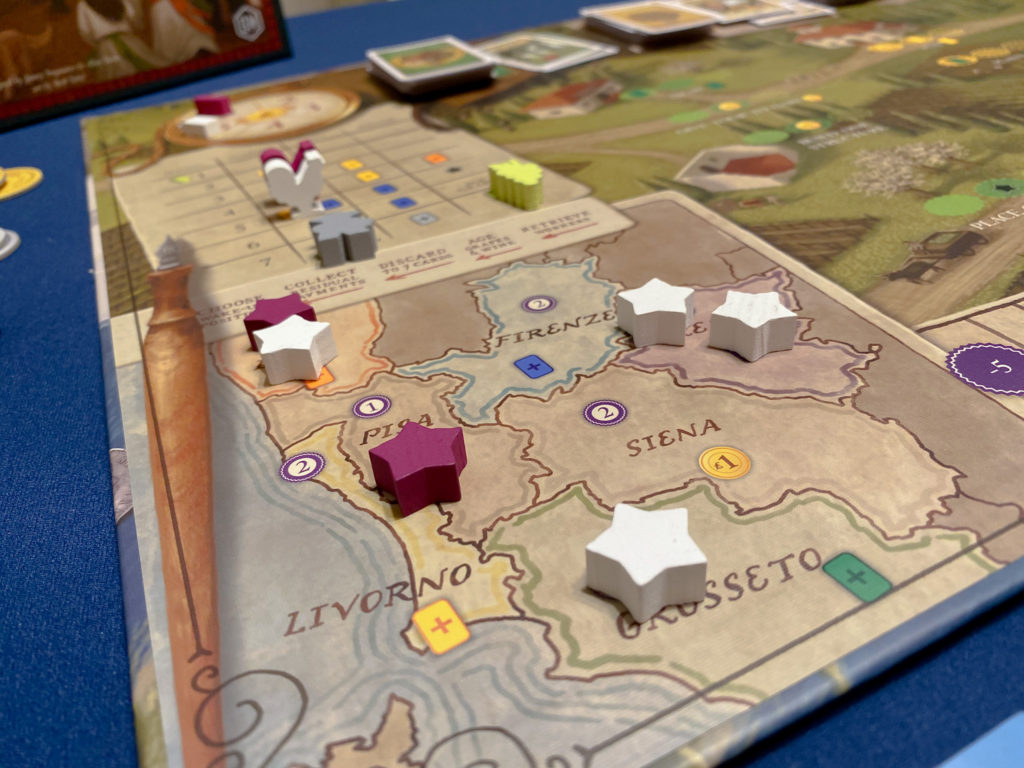
How does it play with two?
As I mentioned in this post, Viticulture is one of my very favorite games to play with two players. The game scales very well and plays tight with two, still providing the fun rush as you try to not get boxed out of actions you really need to take.
Plus, could the theme be any more perfect for a date night? I mean, we don’t even drink and we love it! You’ll definitely want to take a real date night to a local vineyard after playing this!

Summary
Viticulture Essential Edition is Essential for a reason. In my opinion this is an essential addition for any board gamer’s shelf. It’s a perfectly lovely, medium weight worker placement game that shines by being so simple to pick up while filled with such depth to keep you coming back for more. We have loved playing Viticulture for years and I know we will continue for many more to come.
Tuscany Essential Edition is a wonderful expansion that greatly improves an already amazing game that will be sure to delight fans of the original yet still keeps everything straightforward enough that you can jump right in with the expansion modules in your first game.
We love the complete customizable nature of this expansion. It is a breeze to play with one, two, three, or none of the expansion modules depending on what you are in the mood for. All add interesting additions to the Viticulture experience while none of the modules greatly increases the difficulty or length of the game. If anything, the modules opens Viticulture up a bit more so players can successfully pursue different strategies, keeping the game tight without being too punishing or mean.
I wish that the Tuscany game came standard in the base game. But alas, as of now, it does not.
Luckily, you can fit all of the Tuscany expansion content in the base game box, including both game boards! It’s like it knows it’s supposed to be together!
To order a copy of Viticulture for your home, click here!
To pick up the Tuscany expansion, click here!
A special thank you to Stonemaier Games for partnering with us on this review. As always our thoughts and opinions are our own.
Game Info:
Title: Viticulture Essential Edition, Tuscany Essential Edition
1-6 Players Ages 13+
Designer: Jamey Stegmaier, Alan Stone
Artist:
Publisher: Stonemaier Games
If You Enjoyed This Review You May Also Like
Tapestry Review
Wingspan Review
10 More Great Date Night Games


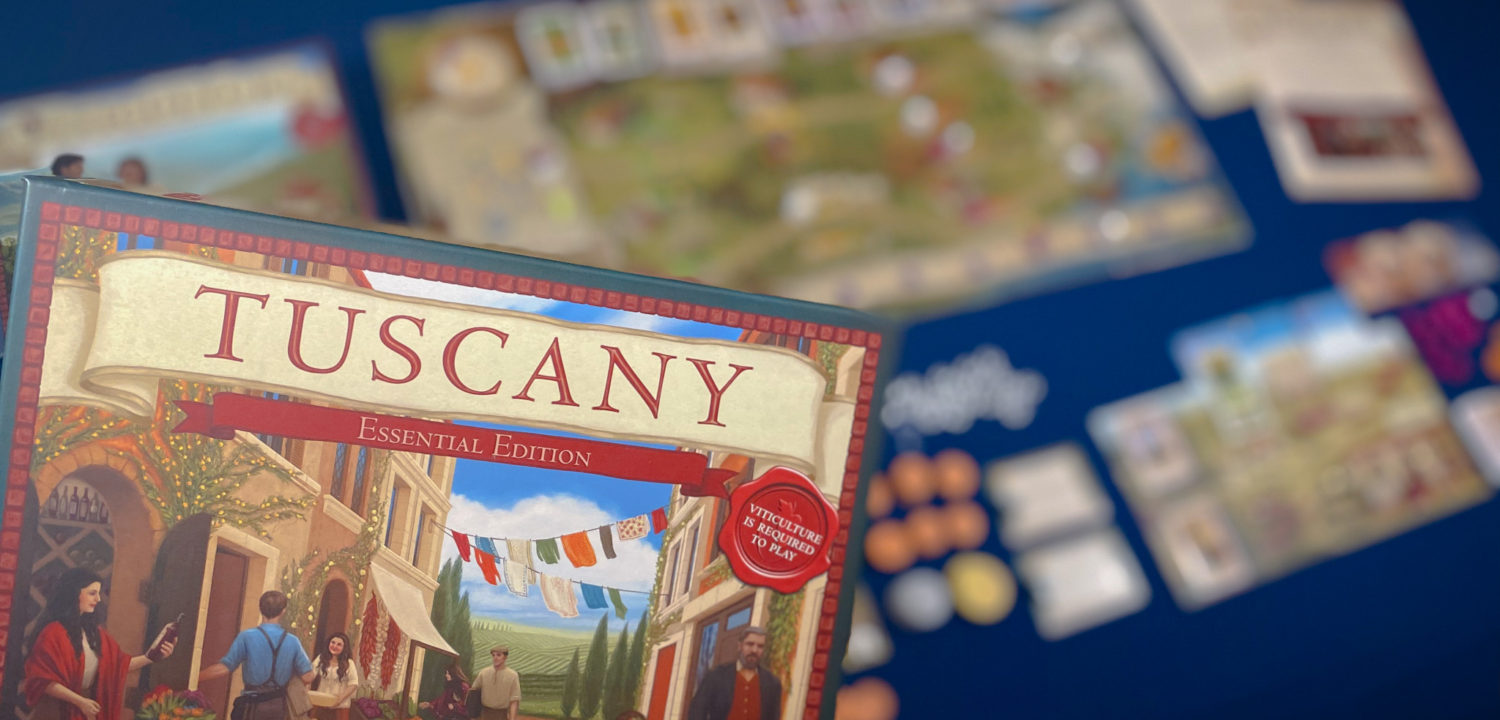









Leave a Comment